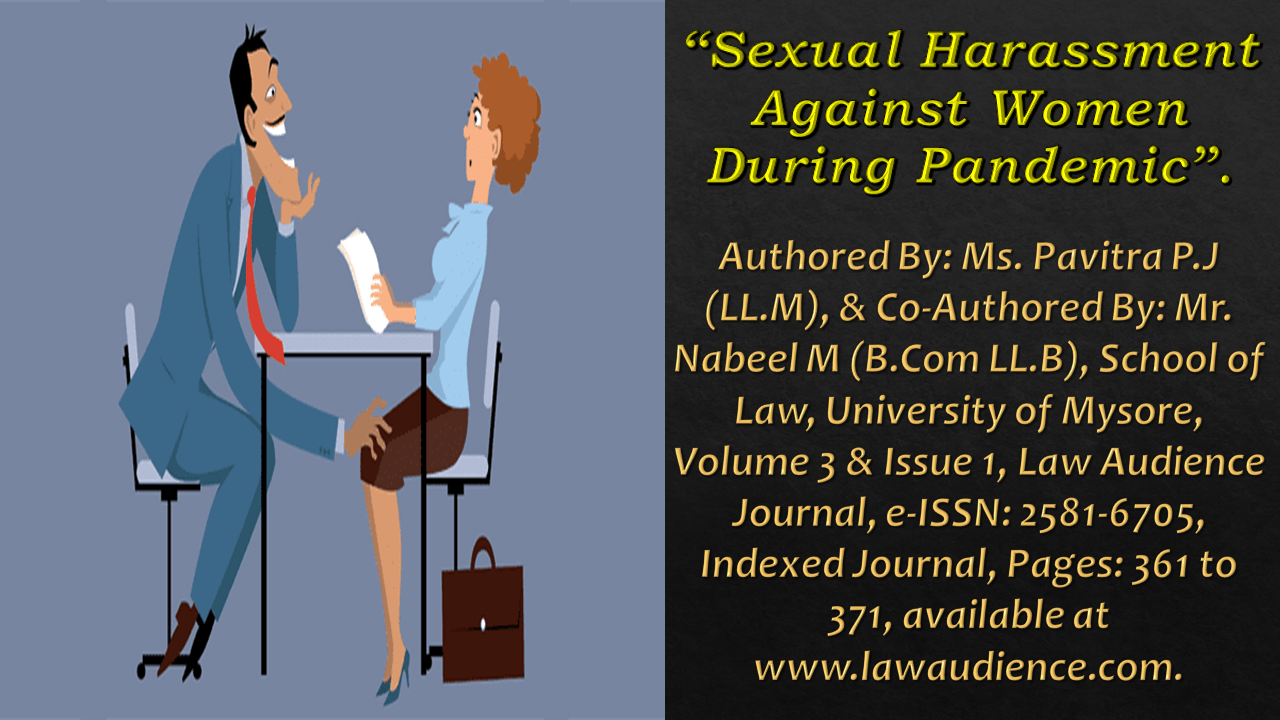Click here to download the full paper (PDF)
Authored By: Ms. Pavitra P.J (LL.M), & Co-Authored By: Mr. Nabeel M (B.Com LL.B), School of Law, University of Mysore,
Click here for Copyright Policy.
ABSTRACT:
“The status of women in India has evolved over the ages. During the ancient period, women enjoyed equal status to men which deteriorated in the medieval period with invasion from foreign powers. With Independence, the Rights of Women were dignified in the Constitution as fundamental rights with the right to equality in Article 14, non-discrimination by the State in Article 15(1), Equality of Opportunity under Article 16, Equal pay for Equal Work in Article 39(d), Special Provisions by the State in favour of Women and Children in Article 15(3), renounces practices derogatory to the dignity of women in Article 51(A) (e), and provisions to be made by the State for securing just and humane conditions of work and for maternity relief in Article 42. In spite of the fact that, there is no specific prohibition on Sexual Harassment in Committee on the Elimination of Discrimination against Women and International Labour Organization, both ILO’s CEACR (Committee of Experts on the Application of Conventions & Recommendations) & CEDAW deals with the sexual harassment. The Prohibition of Sexual Harassment Act, 2013, was enacted to ensure safe working spaces for women and to build enabling work environment that respects the rights of working women to equality of status and opportunity. Working women complain of “online sexual harassment, during the Covid-19 pandemic, while in the virtual office, sexual harassment continues”.
Keywords: Constitution Provision, ILO, CEDAW, Online Sexual Harassment, Social Media, National Commission, Code of Criminal Procedure, IPC, Evidence Act, POSH Act, Complaint Committee.
I. INTRODUCTION:
Today the women have been more empowered, educated & modernized, achieving success in every field, but at the place of work, women are still facing bias in the form of sexual harassment. Of all the forms that violence against women can assume, sexual harassment is the most ubiquitous and insidious, today, people and even organizations are becoming aware about the problem of sexual harassment. In India, it has been only eight years since sexual harassment was for the first time recognized by The Supreme Court as human rights violation and gender-based systemic discrimination that affects women’s Right to Life and Livelihood[1]. The Court defined sexual harassment very clearly as well as provided guidelines for employers to redress and prevent sexual harassment at the workplace. While the Apex Court has given mandatory guidelines, known as Vishaka Guidelines, for resolution and prevention of sexual harassment enjoining employers by holding them responsible for providing a safe work environment for women, the issue still remains under carpets for most women and employers.
“Don’t be ashamed to speak it out! You are the Victim, not the Culprit, Know The Difference!”[2].
II. DEFINITIONS:
According to Black Dictionary, the meaning of sexual harassment in the workplace or discrimination where unwelcome and unwanted advances are made to a person by one or more other employees. the comments are of a personal nature and often sexual in style and manner[3]. It is an open truth that working women have to face problems just by virtue of their being women. According to a study carried out by the National Commission for Women, about half of working women have suffered one or other kinds of harassment at the workplace mental and physical[4].
II.I SEXUAL HARASSMENT – WHAT IT IS?
Causing annoyance to females at their place of work by pestering or taunting, involving unwelcome physical, verbal and non-verbal conduct of a sexual nature. The term ‘sexual harassment’ as a descriptor for this conduct was only coined in the 1970s. Since then, the issue has become a recognized phenomenon throughout the world in all culture sand occupational. [5] The Prevention of Sexual Harassment at the Workplace Act, 2013, (hereinafter referred to as POSH Act), defines “sexual harassment” in line with the supreme court definition of sexual harassment in the Vishaka Judgement. The sexual offence defines under the POSH Act is wide enough to cover both direct or implied sexual conduct which may involve physical verbal or written conduct.[6]
II.II QUID PRO QUO HARASSMENT:
‘Quid Pro Quo’ sexual harassment occurs at the workplace when a job benefit is directly tied to an employee submitting to unwelcome sexual advances. Where any of this act is committed in circumstances where the victim of such conduct has a reasonable apprehension that in relation to the victim’s employment or work whether she is drawing salary, or honorarium or voluntary whether in government, public and private enterprise, such conduct can be humiliating and may constitute a health and safety problem, it amounts to sexual harassment. Anyone who received the sexual harassment from trauma, inferiority complex, depression, may not be able to work normally it deeply affects her family life, psychological breakdown, ashamed, losing or guilty of their job.[7]
II.III WHAT AMOUNTS TO SEXUAL HARASSMENT?
The Supreme Court of India in the case of Vivek vs. State of Rajasthan[8], gave a landmark judgement defining “Sexual Harassment” as any unwelcome sexually determination behaviour (whether directly or by implication) like:
- Physical contact or advances,
- A demand or request for sexual favours,
- Sexually colored remakes,
- Showing pornography, and
- Any other physical, verbal or non-verbal conduct of a sexual nature.
II.III.I Physical Sexual Harassment:
- Physically touching, caressing, kissing, pinching, hugging
- Rape
- Sexual assault
II.III.II Verbal Sexual Harassment:
- Comments about clothes, body or appearance
- Indecent remarks
- Requests for sexual favours
- Sexual demands made by someone of the opposites sex
II.III.III Non-Verbal Sexual Harassment:
- looking and staring at a female’s body
- display of sexually explicit materials such as calendars, pin-ups or magazines.
III. THROUGH THE LENS OF SOCIAL MEDIA:
Social media basically means any human communication or sharing information on internet that occurs through the medium of computer, tablet, or mobile. There are numerous apps and websites and apps that make it possible. It is now becoming one of the largest means of communication. Which enables to share the idea, information news and etc. at much faster speed. 2017 was a landmark year for the conservation of sexual abuse and violence. The hashtag was first recognised when actress Alyssa Milano tweeted it with the message “if you’ve been sexually harassed or assaulted write “me too’ as reply to the tweet.” But however, a year before Milano publicized the ideas of “me too” as a way to give people a sense of the magnitude of the problem of sexual abuse, activism Tarana Burke.[9] This movement followed the public revelations of sexual misconduct allegations against Harvey Weinstein, an award-winning film producer and long-time sexual predator. More than 100 women who worked on Weinstein’s films accused Weinstein of sexual abuse, including harassment, assault and rape. Subsequently, number of women came forward with the allegations of sexual abuse against number of other powerful men in Hollywood and various other industries. This outbreak of accusations paved the way for women all over the world to share their experiences of sexual abuse on social media with the hashtag #Me Too Movement. The rapid expansion of the use of the internet and communication technology has resulted in significant changes, where social interaction is not only mediated by technology but increasingly relies on technology. However, as the use of the internet and information technology has affected an entire person’s life concerns about online threats have expanded to include various online sexual harassment.[10] In today’s politically hostile environment, sexual harassment claims are coming in droves, for example, Trending Twitter hashtags like sexual harassment.
A large number of women reported being subjected to new forms of sexual harassment online such as “zoom-bombing” in a survey conducted by a European Parliament-based campaign group[11]. Further, a recent study carried out by the Charity Rights of Women, United Kingdom, found that the last year’s lockdown exacerbated workplace sexual harassment and is still taking place remotely[12]. Instances of such workplace sexual harassment misconduct included: taking screen captures during video calls without permission and circulating them on social media, managers demanding women colleagues to attend impromptu meetings post office hours, using phallic emoticons, and offering to send pictures. The National Commission for Women in India has recently disclosed that the cases of online sexual harassment had seen an upsurge by five times since the outbreak of the COVID-19 pandemic[13].
IV. ONLINE SEXUAL HARASSMENT:
COVID-19 forced people to stay indoors and constrained companies to shift to work from home mode. Platforms like Zoom, Skype, and Google-Meet became the ideal choice for business meetings. The coronavirus set in motion lockdown, & creates lot of challenges for working women from home for such a long period of time however women are struggling to manage the work-life balance. They are getting unwanted video call request; many women had approached the experts for guidance as they were unsure of how to raise complaints of sexual harassment while working from home. During the lockdown, many women are worried about their job and they are scared of expulsion so they are in doubtful to speak or not. There are no transparent guidelines by the companies on how work from home should function in an organisation and that confuses women[14].
For example, I can’t see you properly, come closer to the camera, her boss demand over a video call, which makes her feel uncomfortable. Complaints received by the National Commission for Women from across the country (periods January 2018- May 2020). The category of complaints is domestic violence, cyber-crime, harassment and rape and sexual assault.[15]
In 2008, the High Court of Delhi in the case of Saurabh Kumar Mallick vs. the Comptroller & Auditor General of India[16], held that the expression “workplace” could not be narrowly described to confine its meaning to the commonly understood expression of an “office” – that is a place where any person of the public could have access. The Court further held that if a person conducting work through video conferencing indulges in the act of sexual harassment with an employee, it cannot be open for him to say that he had not committed the act at a “workplace”. Recently, the High Court of Rajasthan, in its judgment in the case of Sanjeev Mishra vs. Bank of Baroda[17], has widened the scope of the term “workplace harassment” to include online harassment.
V. FOUNDATION IN LAW:
In the eyes of Law, it is considered as a violation of a woman’s fundamental right to live with dignity provided under Article 21 of The Constitution of India. Article 15 expressly prohibits discrimination on the grounds of sex in employment and related opportunities. The offence of Sexual Harassment is also violation of the Right to Equality under Article 14 and Freedom to practice any profession or occupation guaranteed under Article 19(1)(g).[18] In India, the chief source of substantive Criminal Law is The Indian Penal Code, 1860 that lists offences under various heads and punishments related to them. The procedure of complaint, inquiry, investigation, arrest, bail, etc. in the criminal justice system in India is governed by the Code of Criminal Procedure, 1973 and The Evidence Act, 1872 sets out the procedure for producing evidence in the Court of Law. The Sexual Harassment of Women at Workplace (Prevention, Prohibition and Redressal) Act, 2013 is the first legislation in India specifically addressing the issue of Sexual Harassment.
The Sexual Harassment of Women at Workplace (Prevention, Prohibition and Redressal) Act, 2013, aims at preventing such Sexual Harassment in the first place and in case such harassment does occur, it provides for efficient redressal of complaints by setting up of Internal Complaints Committee/Local Complaints Committee and providing compensation and rehabilitation to the victim. It further mandates that employer must form an Internal Complaints Committee and failure to set up such a committee leads to a monetary penalty of Rs. 50,000 under section 26(1) of POSH Act. Regarding the admissibility of social media evidence in Indian Courts, it is noteworthy that after the enactment of The Information Technology Act, 2000 Social Media evidence are considered to be a substantive piece of evidence and legally admissible in the Court of Law under Section-65B of The Evidence Act, 1872.[19] As per Section-468 of The Code of Criminal Procedure, 1973 the period of limitation commences from the date of offence or the day on which such offence comes to the knowledge of the victim or where the perpetrator of crime is unknown, the day on which the identity of the offender is known. The Act also empowers the Court to extend the limitation period, “if it is satisfied on the facts and in the circumstances of the case that the delay has been properly explained or that it is necessary so to do in the interests of justice.”
Under Section-9, The Sexual Harassment of Women at Workplace (Prevention, Prohibition and Redressal) Act 2013, An aggrieved woman has to file a written complaint for Sexual Harassment at workplace within three months from the date of such incident. The limitation period of three months may be extended by the Internals Complaints Committee “if it is satisfied that the circumstances were such which prevented the woman from filing a complaint within the said period. The remedies available to the victims, the cases of Sexual Harassment differ from each other in terms of damage and intensity, the legal remedy for the victims must also be case-specific, reasonable and just.
Lawyer Karuna Nundy writes that “It is important to define the legal route available to women and men who are coming out with their accusations right now. These women have named some influential people of the society and they, in turn, need to be armed with legal firepower to make sure they get the right remedy[20].”
Sexual Harassment complainants may seek civil and criminal remedies simultaneously. Sexual Harassment is a cognisable offence and to take recourse under Criminal Law, the victim has to file an FIR under Section- 354A of Indian Penal Code in the nearest police station, at the residence of the victim or at any convenient place of her choice. FIR sets the process of Criminal Law in motion and can be filed by the victim or any person acquainted with the facts of the case. Alternatively, a private complaint can be filed before a Judicial Magistrate or Metropolitan Magistrate under Section 156(3) read with Section 190 of Code of criminal procedure, who may direct the police to register an FIR. The Criminal Law requires a high threshold of burden of proof beyond reasonable doubt on the prosecution and provides for` stringent punishment.
To seek civil remedy, the aggrieved woman must file a complaint in writing to either the ICC or LCC, as the case may be. Section- 12 of POSH Act provides that at the request of the complainant, the ICC or the LCC may recommend to the employer to provide interim measures such as transferring the aggrieved woman or the respondent to any other workplace and granting leave to the aggrieved woman in addition to her regular leave entitlement.
Section-16 of POSH Act protects the confidentiality of the complainant and prohibits the publication or making known the contents of a complaint and the inquiry proceedings. In case the victim is not satisfied with the investigation procedure, she can move the High Court by way of a writ petition under Article 226 of the Constitution of India and the concerned High Court.
The Ministry of Women & Child Development in 2018 has launched the SHE-BOX that stands for Sexual Harassment Electronics Box, an online platform for reporting complaints of Sexual Harassment. The government, as well as private-sector employees, can use this complaint mechanism and the progress of the investigation can be monitored online by the ministry as well as the complainant. The complaints may also be sent via email at ncw.metoo@gmail.com[21].
Article 39A of the Constitution of India provides that State shall provide equal justice and free legal aid. Section 12 of the Legal Services Authorities Act, 1987 provides that every women victim of an offence is entitled to free legal services irrespective of her social or economic conditions.
Louise Fitzgerald provides a comprehensive view of the five general areas of harassment as follow:
- Gender harassment
- Seductive behaviour
- Sexual bribery e.g., dating
- Sexual coercion
- Sexual imposition e.g., kiss or gab touch. [22]
One of the most problems is what kinds of behaviour put the “sexual” in sexual harassment? it creates a lot of confusion if a person is not comfortable with the touch then directly it can’t consider as sexual touches. Or whether sexual touch only it involves a certain body part.[23]
VI. CONCLUSION:
Sexual harassment of women at the workplace is a serious concern in society which have to be addressed at the grassroots level. Despite various laws which are set up to overcome this situation sexual harassments remain underreported due to lacunas in the formulation and execution of the policies.
The laws should be formulated in a way where it addresses both the physical and phycological trauma that women may face at the workplace. There are various reasons why the victims are reluctant to show up, the main reason being a lack of awareness regarding the rights and remedies available to the injured. Online sexual harassment cases shoot up during Covid-19 as many companies practicing work from home policy. No proper working hours, unwanted video conferences and misuse of phone numbers are some of many violence during this online era of work. It is mandatory to have a proper guideline on how to register a complaint on sexual harassment faced through online media.
Moreover, it is surprising to note that media’s have not given sufficient initiatives to spread the information relating to the laws that protect women against violence and sexual harassment at the workplace.
Through globalization, it is now a common scenario that women being the breadwinner of the family. This incorporates the urgent need to increase the pace of move towards gender justice which has a tremendous role to play in the process of reduction of violence against women at the workplace as this is an era where women are being the breadwinners of the family.
References & Footnotes:
[1] Arvind P. Datar, Datar on Constitution of India, Wadhwa & Company Nagpur, India.
[2] Ibid.
[3] The Black Law Dictionary, 2nd Edition.
[4] Studies are available at http://ncw.nic.in/reports/publications/reports-published-by-the-commission.
[5] Dr. S.K. Mukherjee, Law Relating To Sexual Harassment & Sexual Offences, Kamal Publishers, Pages No. 11, 23, 187.
[6] nishith desai associates, Legal & HR Considerations, Research on Prevention of Sexual Harassment at the Workplace (POSH), available at https://www.nishithdesai.com/fileadmin/user_upload/pdfs/Research%20Papers/Prevention_of_Sexual_Harassment_at_Workplace.pdf.
[7] Dr. Surinder Mediratta, Crimes Against Women And The Law, Delhi Law House,1st edition page no. 64-65.
[8] AIR 1997 SC 3011.
[9] https:// www.reaerchgate.net/publiciton/3257401402-metoo-through-the-lens-of-social-media- #me too through the lens of social media visited on 25 June 2021 3:30 am.
[10]https://www.researchgate.net/publication/345039244_Covid19_Harassment_and_Social_Media_A_Study_of_GenderBased_Violence_Facilitated_by_Technology_During_the_Pandemic.
[11] Martin Banks, ‘Significant Number’ of Victims of New Forms of Sexual Harassment Online, Says Survey, available at https://www.theparliamentmagazine.eu/news/article/significant-number-of-victims-of-new-forms-of-sexual-harassment-online-says-survey.
[12] Rights of Women Survey Reveals Online Sexual Harassment Has Increased, As Women Continue To Suffer Sexual Harassment Whilst Working Through The Covid-19 Pandemic, available at https://rightsofwomen.org.uk/news/rights-of-women-survey-reveals-online-sexual-harassment-has-increased-as-women-continue-to-suffer-sexual-harassment-whilst-working-through-the-covid-19-pandemic/.
[13] The Shadow Pandemic: Violence Against Women During COVID-19, available at https://www.unwomen.org/en/news/in-focus/in-focus-gender-equality-in-covid-19-response/violence-against-women-during-covid-19.
[14] https://government.economictimes.indiatimes.com/news/digital-india/lockdown-working-women-complain-of-online-sexual-harassment-say-experts/76150527 29 June 2021 9:33 pm.
[15] https://www.ideasforindia.in/topics/social-identity/covid-19-shadow-pandemic-and-violence-against-women.html visited on 30 Jun. 21.
[16] Civil Writ Petition No. 8649 of 2007.
[17] (SB Civil Writ Petition no. 150/2021).
[18] https://www.legalserviceindia.com/law/article/1122/16/-metoo-movement-legal-implications-remedies- visited on 26 June 2021 (1:00 pm).
[19] state of Karnataka v. Krishnappa, (2000) 4 SCC 75page no. 170.
[20] Navin Kumar Jaggi, Legal Implications of #Metoo Movement, available at https://www.linkedin.com/pulse/legal-implications-metoo-movement-navin-kumar-jaggi.
[21] Govt Launches ‘She-Box’ Portal For Sexual Harassment Complaints, available at https://www.thehindu.com/news/national/govt-launches-she-box-portal-for-sexual-harassment-complaints/article19342828.ece.
[22] Dr. Vandana, Sexual Violence Against Women: Penal Law And Human Rights Perspectives.
[23] Martin D. Schwartz, Researching Sexual Violence Against Women, Sage Publication.
Cite this article as:
Ms. Pavitra P.J & Mr. Nabeel M, Sexual Harassment Against Women During Pandemic, Vol.3 & Issue 1, Law Audience Journal, Pages 361 to 371 (12th July 2021), available at https://www.lawaudience.com/sexual-harassment-against-women-during-pandemic/.



